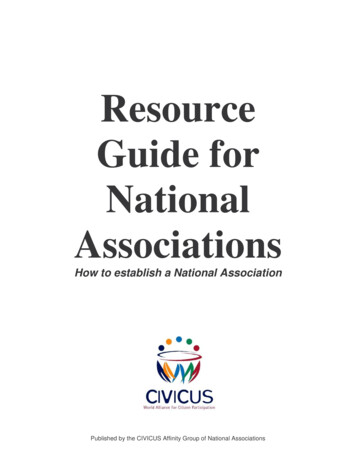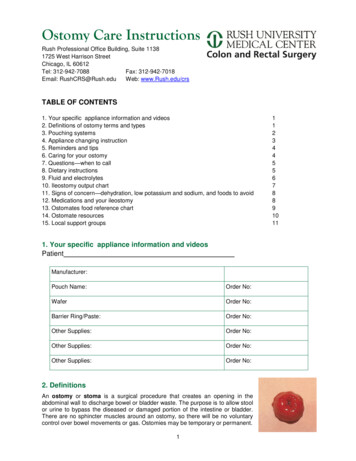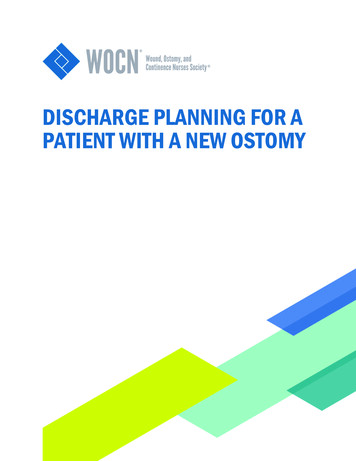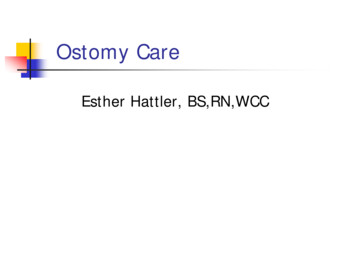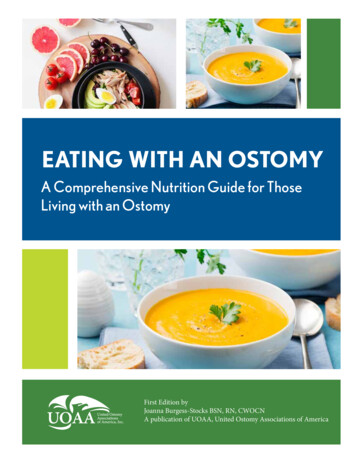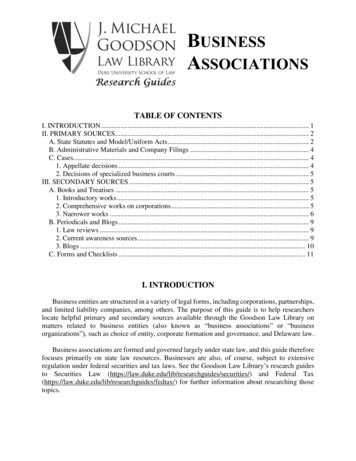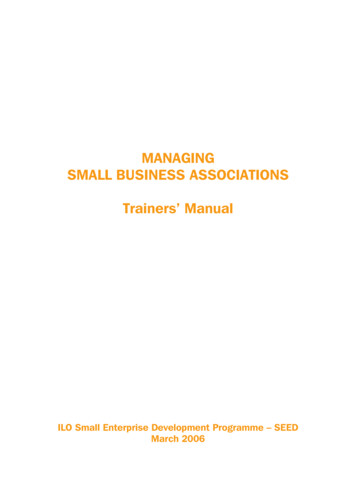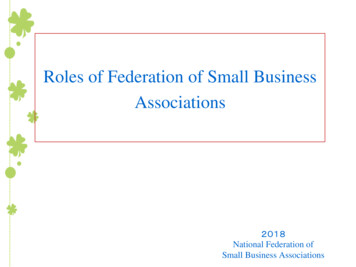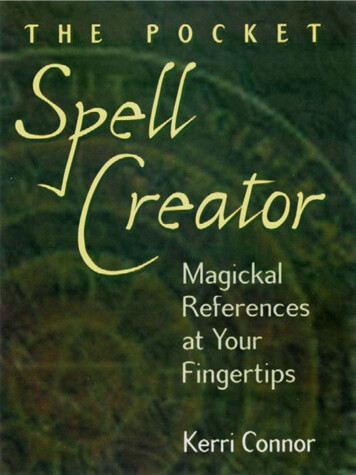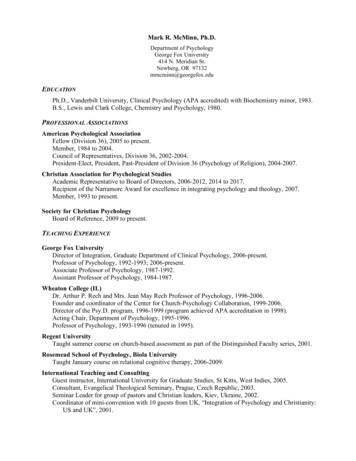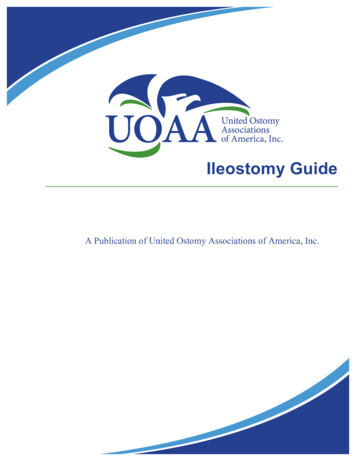
Transcription
Ileostomy GuideA Publication of United Ostomy Associations of America, Inc.
A Message To You.Ileostomy surgery is a lifesaving surgery that enables a person to enjoy afull range of activities, including traveling, sports, family life and work.Thousands of people annually undergo ostomy surgery for various reasonsand return to a healthy, functioning lifestyle. The United OstomyAssociations of America (UOAA) is a volunteer organization dedicatedto helping those who have or will have ostomy orother diversionary surgery by providing one-on-one support, local support groupmeetings, conferences, and educational material through its web site, printedmaterial and The Phoenix magazine.You have many peers in the UOAA who are ready to answer yourquestions, provide support and reassure you that you can have a full,productive life after ostomy surgery.We invite you to join us as we fulfill our mission in helping others.From the United Ostomy Associations of America
ILEOSTOMY GUIDEReviewed by:Barbara Morrow, RN, MSN,CWOCN 2017Nancy Gutman, RN, CWOCN2011This guidebook is available for free, in electronic form, from the United Ostomy Associations of America(UOAA). It was originally produced, copyrighted and sold by the United Ostomy Association (UOA), thenational US ostomy organization from 1962 to 2005, which released its copyrights on this material.UOAA may be contacted at:www.ostomy.org info@ostomy.org 800-826-0826
CONTENTSINTRODUCTION . . . . . . . . . . . . . . . . . . . . . . . . . . . . . . . . . . . . . . . . . . . . 6FACTS ABOUT ILEOSTOMIES . . . . . . . . . . . . . . . . . . . . . . . . . . . . . . . . . . 7NORMAL DIGESTIVE SYSTEM. . . . . . . . . . . . . . . . . . . . . . . . . . . . . . . . . . 8Small intestine. . . . . . . . . . . . . . . . . . . . . . . . . . . . . . . . . . . . . . . . . . . . . . . . . . . . . . . 8Large intestine . . . . . . . . . . . . . . . . . . . . . . . . . . . . . . . . . . . . . . . . . . . . . . . . . . . . . . 8TYPES OF SMALL BOWEL DIVERSION . . . . . . . . . . . . . . . . . . . . . . . . . . . 9Ileoanal reservoir (J-Pouch) . . . . . . . . . . . . . . . . . . . . . . . . . . . . . . . . . . . . . . . . . . . .9Brooke ileostomy . . . . . . . . . . . . . . . . . . . . . . . . . . . . . . . . . . . . . . . . . . . . . . . . . . . .9Continent ileostomy . . . . . . . . . . . . . . . . . . . . . . . . . . . . . . . . . . . . . . . . . . . . . . . .10MANAGEMENT FOR BROOKE ILEOSTOMIES . . . . . . . . . . . . . . . . . . . . 11Choosing a pouching system . . . . . . . . . . . . . . . . . . . . . . . . . . . . . . . . . . . . . . . . 11Pouches . . . . . . . . . . . . . . . . . . . . . . . . . . . . . . . . . . . . . . . . . . . . . . . . . . . . . . . . . . 12Measuring for a proper fit . . . . . . . . . . . . . . . . . . . . . . . . . . . . . . . . . . . . . . . . . . . . .12Belts . . . . . . . . . . . . . . . . . . . . . . . . . . . . . . . . . . . . . . . . . . . . . . . . . . . . . . . . . . . . .12Changing the pouching system . . . . . . . . . . . . . . . . . . . . . . . . . . . . . . . . . . . . . . . . 12Factors that influence pouching system seal . . . . . . . . . . . . . . . . . . . . . . . . . . . . . . 13Emptying the pouch . . . . . . . . . . . . . . . . . . . . . . . . . . . . . . . . . . . . . . . . . . . . . . . . . 13Ostomy supplies . . . . . . . . . . . . . . . . . . . . . . . . . . . . . . . . . . . . . . . . . . . . . . . . . . .13HELPFUL HINTS . . . . . . . . . . . . . . . . . . . . . . . . . . . . . . . . . . . . . . . . . . . . 14Protecting the skin around the stoma . . . . . . . . . . . . . . . . . . . . . . . . . . . . . . . . . . . 14Spots of blood on the stoma . . . . . . . . . . . . . . . . . . . . . . . . . . . . . . . . . . . . . . . . . . 14Removing hair under the pouch . . . . . . . . . . . . . . . . . . . . . . . . . . . . . . . . . . . . . . . . 15Flatulence (gas) . . . . . . . . . . . . . . . . . . . . . . . . . . . . . . . . . . . . . . . . . . . . . . . . . . . . . 15Odor . . . . . . . . . . . . . . . . . . . . . . . . . . . . . . . . . . . . . . . . . . . . . . . . . . . . . . . . . . . . . 16Medications/absorption . . . . . . . . . . . . . . . . . . . . . . . . . . . . . . . . . . . . . . . . . . . . . . 16ILEOSTOMY COMPLICATIONS . . . . . . . . . . . . . . . . . . . . . . . . . . . . . . . . 16Severe skin problems . . . . . . . . . . . . . . . . . . . . . . . . . . . . . . . . . . . . . . . . . . . . . . . . 16Obstruction/Blockage . . . . . . . . . . . . . . . . . . . . . . . . . . . . . . . . . . . . . . . . . . . . . . . . 16Diarrhea . . . . . . . . . . . . . . . . . . . . . . . . . . . . . . . . . . . . . . . . . . . . . . . . . . . . . . . . . . .17Electrolyte balance . . . . . . . . . . . . . . . . . . . . . . . . . . . . . . . . . . . . . . . . . . . . . . . . . . 17Phantom rectum . . . . . . . . . . . . . . . . . . . . . . . . . . . . . . . . . . . . . . . . . . . . . . . . . . . . 18Short bowel syndrome . . . . . . . . . . . . . . . . . . . . . . . . . . . . . . . . . . . . . . . . . . . . . . . 18Medical emergencies . . . . . . . . . . . . . . . . . . . . . . . . . . . . . . . . . . . . . . . . . . . . . . . . 18Hospitalization . . . . . . . . . . . . . . . . . . . . . . . . . . . . . . . . . . . . . . . . . . . . . . . . . . . .19LIVING WITH AN ILEOSTOMY . . . . . . . . . . . . . . . . . . . . . . . . . . . . . . . . 19Telling others . . . . . . . . . . . . . . . . . . . . . . . . . . . . . . . . . . . . . . . . . . . . . . . . . . . . . 194
Clothing and appearance . . . . . . . . . . . . . . . . . . . . . . . . . . . . . . . . . . . . . . . . . . . . . 19Eating and digestion . . . . . . . . . . . . . . . . . . . . . . . . . . . . . . . . . . . . . . . . . . . . . . . . . 19Returning to work . . . . . . . . . . . . . . . . . . . . . . . . . . . . . . . . . . . . . . . . . . . . . . . . . . . 20Intimacy and sexuality . . . . . . . . . . . . . . . . . . . . . . . . . . . . . . . . . . . . . . . . . . . . . . . 20Participating in sports . . . . . . . . . . . . . . . . . . . . . . . . . . . . . . . . . . . . . . . . . . . . . . . . 21Bathing and swimming . . . . . . . . . . . . . . . . . . . . . . . . . . . . . . . . . . . . . . . . . . . . . . . 21Travel . . . . . . . . . . . . . . . . . . . . . . . . . . . . . . . . . . . . . . . . . . . . . . . . . . . . . . . . . . . . . 22FOR PARENTS OF CHILDREN WITH ILEOSTOMIES . . . . . . . . . . . . . . . . 25Psychosocial issues . . . . . . . . . . . . . . . . . . . . . . . . . . . . . . . . . . . . . . . . . . . . . . . . . 25Management issues . . . . . . . . . . . . . . . . . . . . . . . . . . . . . . . . . . . . . . . . . . . . . . . . . 25Everyday living . . . . . . . . . . . . . . . . . . . . . . . . . . . . . . . . . . . . . . . . . . . . . . . . . . . . . 25RESOURCES AVAILABLE . . . . . . . . . . . . . . . . . . . . . . . . . . . . . . . . . . . . . 27United Ostomy Associations of America . . . . . . . . . . . . . . . . . . . . . . . . . . . . . . . . . 27International Ostomy Association . . . . . . . . . . . . . . . . . . . . . . . . . . . . . . . . . . . . 28Wound Ostomy Continence Nurses Society . . . . . . . . . . . . . . . . . . . . . . . . . . . . . . 28Agencies . . . . . . . . . . . . . . . . . . . . . . . . . . . . . . . . . . . . . . . . . . . . . . . . . . . . . . . . . .28Medicare, Medicaid and Social Security in the United States . . . . . . . . . . . . . . . . . 28GLOSSARY . . . . . . . . . . . . . . . . . . . . . . . . . . . . . . . . . . . . . . . . . . . . . . . 285
INTRODUCTIONAn ileostomy is a life-saving surgery that enables individuals to enjoy a full range ofactivities including traveling, sports, family life and work, even though they have astoma and wear a pouching system.Ileostomy surgery is performed for many different diseases and conditions. Some ofthe indications for ileostomy surgery are ulcerative colitis, Crohn’s disease, familialpolyposis, trauma and complications of cancer.There is no one way to take care of an ileostomy. Just as ileostomies differ, so doeshow to take care of them. This guide book gives you suggestions and ideas formanaging your ileostomy. Discuss the ideas with a physician (or a) and Wound OstomyContinence Nurse (WOCN), hereinafter referred to as ostomy nurse, and adapt (them)the suggestions and ideas to your situation. Give new things a fair trial, but do not insiston them if they fail to make you more comfortable. What is good for someone else maynot be good for you.When an individual can independently perform their own ostomy care, they feelmuch better about themselves and will enjoy a much better quality of life. Mastery ofself-care skills is key to adjusting to life with an ostomy. The sooner you learn to takecare of your ileostomy, the better you are likely to feel about yourself. In time, you willgain confidence in your self-care.There are many ways to gain a greater understanding of your life with an ileostomy.Your physician and ostomy nurse are important sources of information and support. Inaddition, much information is available at various Web sites (see Resources).Taking part in an ostomy support group allows you to share your feelings and askquestions as you make progress with your adjustment. It also allows you to share yoursuccessful adjustment with others who may need the benefit of your experience. Mostostomy visitor programs are sponsored by local support groups of the United OstomyAssociations of America (UOAA). If you would like a visitor or to take part in a supportgroup, ask your physician, ostomy nurse, or other nurses to make a referral. You oryour family may also locate your local UOAA support group by calling 800-826-0826 orvisiting www.ostomy.org.6
FACTS ABOUT ILEOSTOMIESAn ileostomy is a surgically created opening in the abdominal wall. The end of theileum (the lowest portion of the small intestine) is brought through the abdominal wall toform a stoma, usually on the lower right side of the abdomen. When you look at yourstoma, you are actually looking at the lining (or mucosa) of the intestine, which is likethe lining of your cheek.The stoma will appear pink to red and will be moist and shiny. It will reduce in sizeover a short period of time after surgery. The shape will be round to oval and mayprotrude or be flush with the skin.An ileostomy may be permanent or temporary depending upon the reason forsurgery. The entire colon, rectum, and anus are removed or bypassed with apermanent ileostomy and normal colon and rectal functions are no longer present.With a temporary ileostomy, all or part of the colon is removed, but part or all of therectum is left intact, and may eventually be reversed.The major function of the small intestine is to absorb the body’s nutrients and water.Enzymes released into the small intestine break food into small particles so that vitallyneeded proteins, carbohydrates, fats, vitamins and minerals can be absorbed. Theseenzymes will also be present in ileostomy discharge, and they can cause skinbreakdown. This is why the skin around an ileostomy must always be protected (seeSkin Protection).After (removal of the colon and rectum) creation of an ileostomy, digestive contentspass out of the body through the stoma and are collected in an individually fitteddrainable pouch, which is worn at all times. The consistency of the ileostomy outputwill be liquid to pasty, depending on one’s diet, medications and other factors.Because the output is constant, the pouch will need to be emptied 5-8 times a day.
NORMAL DIGESTIVE SYSTEMAlthough an ileostomycreates an important change fora patient, the body’s chemistryand digestive function are notsignificantly altered by it. Adescription of the large andsmall intestine may help youunderstand the changes to yourbody. Approximately 20 feet long,consisting of:inches long beginning atthe outlet of the stomach. Jejunum (second part),Duodenum (first part) 10-12about 8-9 feet long. Ileum (third part), about 12 feet long connecting to the large intestine at thececum. Food nutrients are digested and absorbed in the small intestine as food is movedthrough by peristalsis.Large Intestine Approximately 5-7 feet long, consisting of: Cecum – contains the ileocecal valve, which prevents reflux into the ileum;contents are highly acidic liquid Ascending colon – contents are acidic liquid Transverse colon – contents are less acidic liquid Descending/sigmoid colon – contents become more formed Rectum – formed stool The primary functions of the large intestine are absorption of water andelectrolytes, transport of stool by peristalsis, and storage of digestive waste until itis eliminated from the body.8
TYPES OF SMALL BOWEL DIVERSIONSThere are three major types of small bowel diversions (when the entire colon isremoved). The surgeon and the patient should determine the most appropriate surgeryfor the patient. Some of the selection criteria for the type of diversion are the diseaseprocess, age, general health and the preference of the patient.1. Ileoanal Reservoir (J-Pouch)Indications: Ulcerative Colitis Familial Polyposis Cancer complications-IntestineDischarge: Soft, formed stool 6-8 per dayManagement: Natural evacuation; Peri-anal skin protectionThe most common surgical variation is the ileoanal reservoir(pelvic pouch) which is an internal pouch made of the ileum and(placed in the pelvis) attached to the rectum. Other names forpelvic pouches include J-pouch and S-pouch depending on thesurgical procedure. These procedures usually require more thanone surgery. The sphincter muscle surrounding the anal openingmust be intact to keep the pouch from leaking. The consistency ofthe output of the pelvic pouch depends on diet and may be aidedby medications. For additional information on the ileoanalreservoir or j-pouch, please see the Ileoanal ResvervoirGuidebook.2. Brooke IleostomyIndications: Ulcerative Colitis Crohn’s Disease Familial PolyposisDischarg
ILEOSTOMY GUIDE Reviewed by: Barbara Morrow, RN, MSN, CWOCN 2017 Nancy Gutman, RN, CWOCN 2011 This guidebook is available for free, in electronic form, from the United Ostomy Associations of America (UOAA). It was originally produced, copyrighted and sold by the United Ostomy Association (UOA), the national US ostomy organization from 1962 to 2005, which released its
